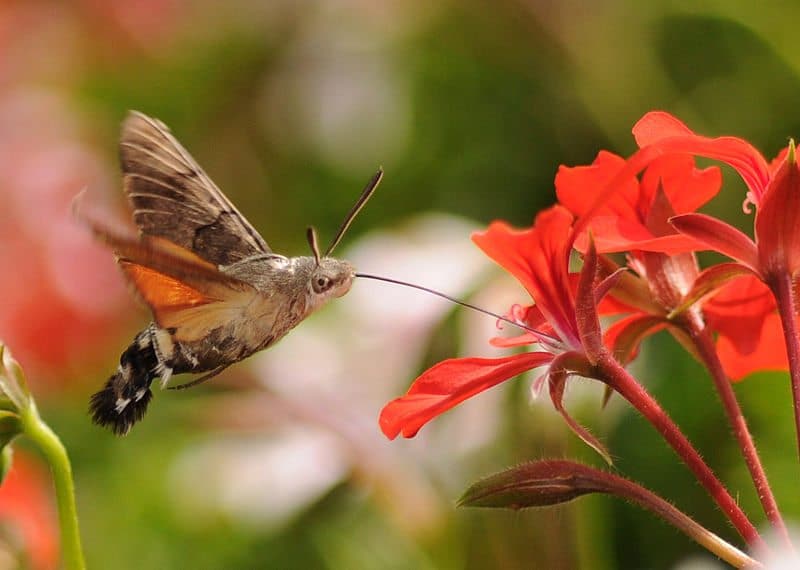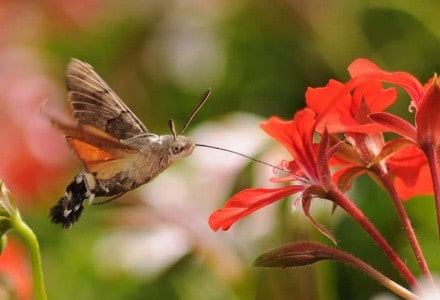
Hummingbird Hawk Moth Facts
- This Lepidoptera primarily goes by the common name of the Hummingbird Hawk Moth. Entomologists, however, know it better by its official scientific name. That, though, is the hard to pronounce term of Macroglossum stellatarum.
- Whatever name one chooses to use to refer to it, it’s a fabulous creature. The first recognition of it as a separate and distinct species, meanwhile, occurred in the year 1758. It further owes its acknowledgement to a famous name in science.
- That’s because the famous Swedish botanist, Carl Linnaeus, made that original scientific classification of the species. He also published it in the 10th edition of his Systema Naturae. This gives the insect a historic place in the annals of entomology.
- Its relative fame doesn’t end there, though. That’s due to the fact that it held a place in important, groundbreaking scientific studies. More precisely, in 2018, a lengthy and detailed project completed the sequencing of its entire genome and mitogenome.
- There’s also more good news. For the moment, the Hummingbird Hawk Moth appears to be maintaining a sizeable and stable population. This delightful trend further seems to hold true throughout the entirety of its natural range.
- The IUCN, therefore, presently has no listing for it on the organizations Red List of Threatened Species. The species nonetheless could face threats to its existence in the future. That’s because habitat loss and climate change continue to escalate.
Related Articles
Plume Moth Venezuelan Poodle Moth Luna Moth
Public Domain Image
Hummingbird Hawk Moth Physical Description
The magnificent Hummingbird Hawk Moth adroitly proves that size holds no relation to beauty in Nature. This holds true since it only qualifies as a medium-sized type of moth, in terms of wingspan. Also unusually, it shows no noticeable sign of sexual dimorphism.
This lack of visual difference between the genders extends to both size and appearance. As a result, mature specimens of both sexes attain an average wingspan of about 1.8 in (4.6 cm). While not large, those wings nevertheless impress one, just due to their beauty.
The forewings typically show brown and a crisscrossing of thin black lines. The hind wings of the arthropod, though, usually show orange and display a black edge. Although the wings grow medium-sized, the body remains proportionately larger than related species.
The proboscis of the amazing Hummingbird Hawk Moth, however, developed in a remarkable manner. It’s highly elongated, again mimicking the hummingbird. The arthropod even possesses a short tail tipped with numerous soft, brush-like bristles.
- Kingdom: Animalia
- Phylum: Arthropoda
- Class: Insecta
- Order: Lepidoptera
- Family: Sphingidae
- Genus: Macroglossum
- Species: M. stellatarum
Hummingbird Hawk Moth Distribution, Habitat, and Ecology
The marvelous Hummingbird Hawk Moth possesses yet another strong evolutionary advantage. That’s the fact that it evolved as native to a huge portion of the globe. More precisely, its natural distribution covers much of Asia, Africa, and also Northern Europe.
Even beyond that, most individuals develop as relatively strong fliers. As a result, the species appears virtually anywhere in the hemisphere during the summer. This represents yet another manner in which it differentiates itself from the majority of its peers.
Adding even more to its resume, the amazing invertebrate also evolved as highly adaptable. Due to that trait, it often inhabits a wide variety of habitats. These include regions as diverse as forests, meadows, parks, and even private gardens around human habitations.
Unfortunately for its fans, though, it has a short lifespan. Because of this trait, however, it developed another helpful trait. The marvel of Nature breeds quickly. Therefore, anywhere from 2-4 generations are born in a single season. This often depends on the region, as well.
The mature adults of the Hummingbird Hawk Moth feed exclusively on nectar from plants such as the Red Valerian and Honeysuckle. Thankfully, the species itself, however, has few natural predators. This mainly holds true due to its incredible camouflage.
Species Sharing Its Range
Tansy Beetle Shrill Carder Bee English Oak
Check out our other articles on 5 Fabulous Deer Varieties, Tassled Scorpionfish, Erta Ale, Eastern Diamondback Rattlesnake, Chatham Island forget-me-not, Pacu

